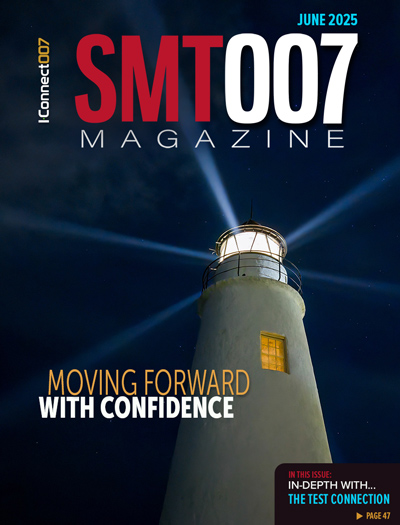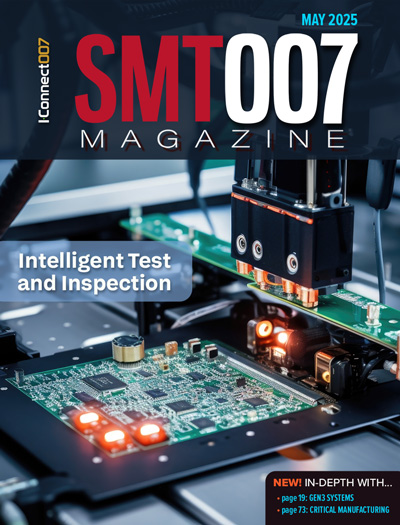-

- News
- Books
Featured Books
- smt007 Magazine
Latest Issues
Current Issue
What's Your Sweet Spot?
Are you in a niche that’s growing or shrinking? Is it time to reassess and refocus? We spotlight companies thriving by redefining or reinforcing their niche. What are their insights?

Moving Forward With Confidence
In this issue, we focus on sales and quoting, workforce training, new IPC leadership in the U.S. and Canada, the effects of tariffs, CFX standards, and much more—all designed to provide perspective as you move through the cloud bank of today's shifting economic market.

Intelligent Test and Inspection
Are you ready to explore the cutting-edge advancements shaping the electronics manufacturing industry? The May 2025 issue of SMT007 Magazine is packed with insights, innovations, and expert perspectives that you won’t want to miss.
- Articles
- Columns
- Links
- Media kit
||| MENU - smt007 Magazine
Lockheed Martin Awarded GeoXO Lightning Mapper Contract to Support Forecasters with Severe Weather Monitoring
September 19, 2024 | Lockheed MartinEstimated reading time: 2 minutes
NASA has awarded Lockheed Martin (NYSE: LMT) a contract to design and build the next-generation GeoXO Lightning Mapper (LMX) instruments for the National Oceanic and Atmospheric Administration (NOAA). The baseline contract is valued at approximately $297 million for two instruments with options for two additional instruments.
The Capabilities
LMX is a single-channel, near-infrared optical instrument developed specifically to detect, locate, and measure the intensity, duration and extent of lightning flashes in near-real-time.
The LMX instrument detects and measures lightning flashes while onboard NOAA's next-generation GeoXO weather satellites. This lightning data will provide persistent severe weather observations of the Western Hemisphere, improving storm analysis and prediction, and aiding the detection of tornado-producing storms. The imagers will improve hurricane intensity calculations, lightning hazard detection, wildfire ignition detection and aviation threat avoidance.
LMX builds on the work of the first operational lightning mapper flown in geostationary orbit — the Lockheed Martin-built Geostationary Lightning Mapper (GLM). Specifically, LMX will improve on GLM with finer spatial resolution and faster imaging of lightning activity, in addition to a wider field of view of the Western Hemisphere, which will now include Alaska. Lockheed Martin will develop and build the LMX instruments at its Sunnyvale, California, facility.
"Lockheed Martin improved upon the success of the Geostationary Lighting Mapper and added game-changing technologies to the GeoXO Lightning Mapper, including an advanced imaging sensor that will potentially detect 25% more lightning pulses," said Matthew Mahlman, director of Weather, Earth Science and Climate Intelligence at Lockheed Martin. "This advanced technology will give meteorologists a tool to create greater lead time in alerting people to severe storms and dangerous weather situations such as rapid intensifying hurricanes."
Building on Success
The GeoXO weather satellite system is NOAA's next generation of satellites following the successful Geostationary Operational Environmental Satellites (GOES) series – the last of which, GOES-U, launched on June 25, 2024. That satellite is now in geostationary orbit undergoing on-orbit checkout and verification and is has been renamed GOES-19.
In June, NASA awarded Lockheed Martin a contract to develop and build the GeoXO spacecraft, for NOAA. The baseline contract is for three spacecraft with options for four additional spacecraft. The total estimated value of the contract including options is $2.27 billion and first launch is planned for the early 2030s.
For over 50 years, Lockheed Martin has designed and built more than 120 weather and environmental spacecraft, and many Earth observation instruments for civil government, military and commercial applications. These one-of-a-kind instruments include the Solar Ultraviolet Imager (SUVI) – which is flying on the GOES-R series satellites – as well the as the Interface Region Imaging Spectrograph (IRIS) and James Webb Space Telescope's primary infrared imager, NIRCam.
Testimonial
"In a year when every marketing dollar mattered, I chose to keep I-Connect007 in our 2025 plan. Their commitment to high-quality, insightful content aligns with Koh Young’s values and helps readers navigate a changing industry. "
Brent Fischthal - Koh YoungSuggested Items
Lockheed Martin-Built GOES-U Weather Satellite Successfully Launched
07/01/2024 | Lockheed MartinAn advanced weather satellite built by Lockheed Martin for the National Oceanic and Atmospheric Administration (NOAA) launched from NASA's Kennedy Space Center.
Fluid Truck Orders 600 Lightning Electric Vehicles
10/09/2020 | PR NewswireLightning Systems, a provider of complete electrification solutions for urban commercial fleets, announces that Fluid Truck, a national truck rental platform, will incorporate 600 Lightning Electric vehicles onto their platform, with availability starting in Q4 2020.
Northrop Grumman Awards Contracts to Kitron
06/25/2020 | PRWEBNorthrop Grumman Corporation has awarded Kitron a contract for production of Integrated Communications, Navigation and Identification (ICNI) modules for the F-35 Lightning II program. Deliveries will secure a backlog into 2021 and have a total value of more than USD 18 million.
Fairview Microwave Releases New Series of RF Surge Protectors Featuring 4.3-10 Connectors
12/11/2019 | Infinite ElectronicsNew Coaxial RF Surge Protectors Support Frequency Ranges of 698 MHz to 2.7 GHz
World's First Electric Race Plane Unveiled at Dubai Airshow
11/18/2019 | Air Race EThe world’s first electric race plane has been unveiled on day one at the Dubai Airshow, showcasing custom modified technology built by one of the racing teams set to take part in the inaugural Air Race E event next year. The racing series will provide a testbed for innovation and accelerate the journey towards electric commercial travel.


